More than any other, the caterpillars of Monarch butterflies are most closely associated with eating milkweed–anything in the Asclepias family. With their distinctive black, white and gold pin-striped suits and expressive dark tentacles reaching out into the universe, that’s no surprise.
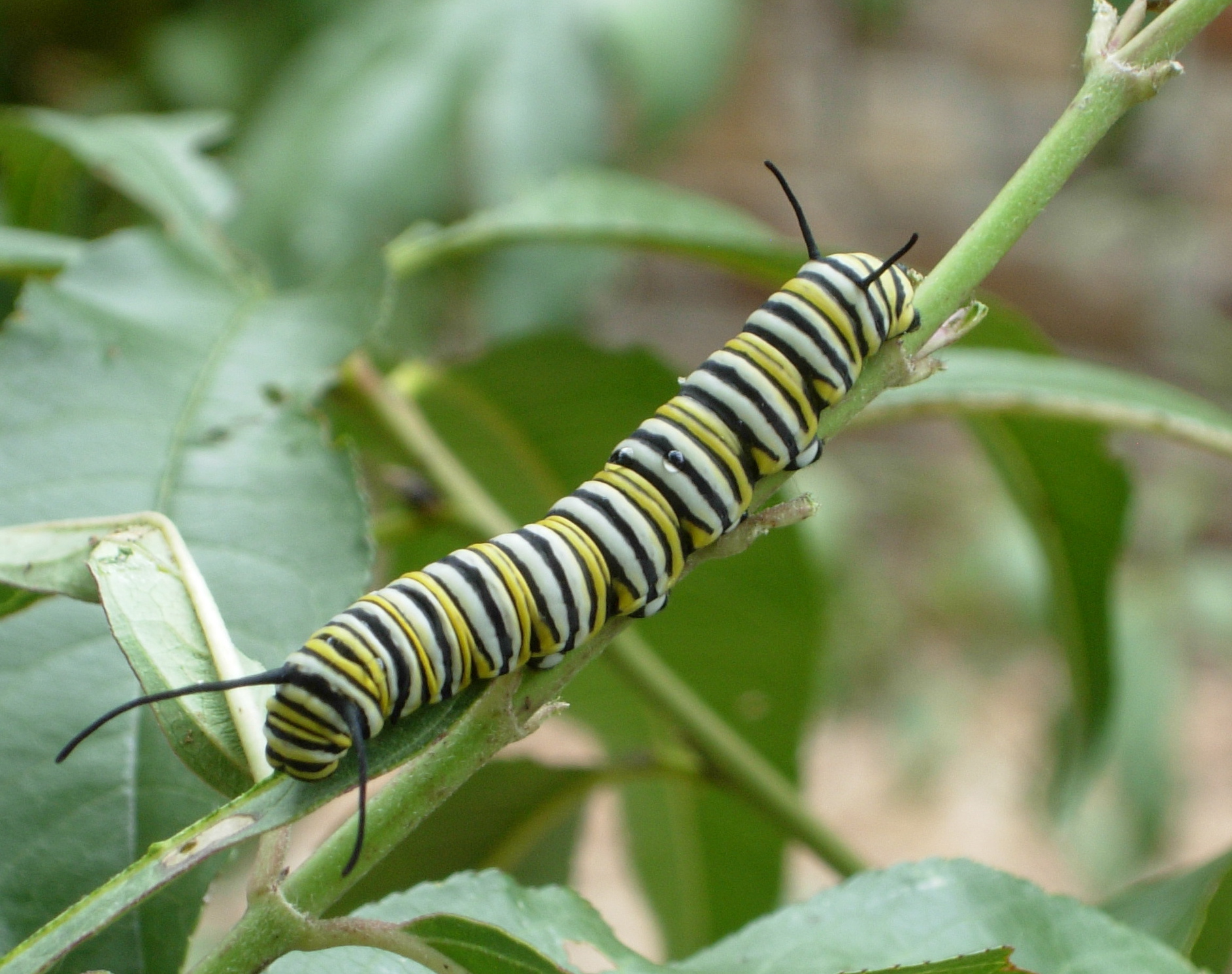
Monarch butterfly caterpillar on milkweed, its host plant. Photo by Monika Maeckle
They’re endearing, ubiquitous, easy to identify and we have a special relationship with them. But there’s a at least three other caterpillars that eat milkweed for breakfast, lunch and dinner.
Last week I noticed this fellow noshing on a pot of Swamp milkweed, Asclepias incarnata.
My first thought: “That ain’t no Monarch.”
Correct. It’s the Striped garden caterpillar, Trichordestra legitimata, which feasts not only on milkweed but other common garden greens–clover, goldenrod, yarrow, grasses and others. The Striped garden caterpillar turns into the rather nondescript Striped garden caterpillar moth, a grey, smallish creature with little black diamonds on his back. Check out these photos on Bugguide.net.
Here’s a better picture of the caterpillar, via Molly Jacobson.

That ain’t no Monarch. It’s a Striped garden caterpillar. Photo by Monika Maeckle
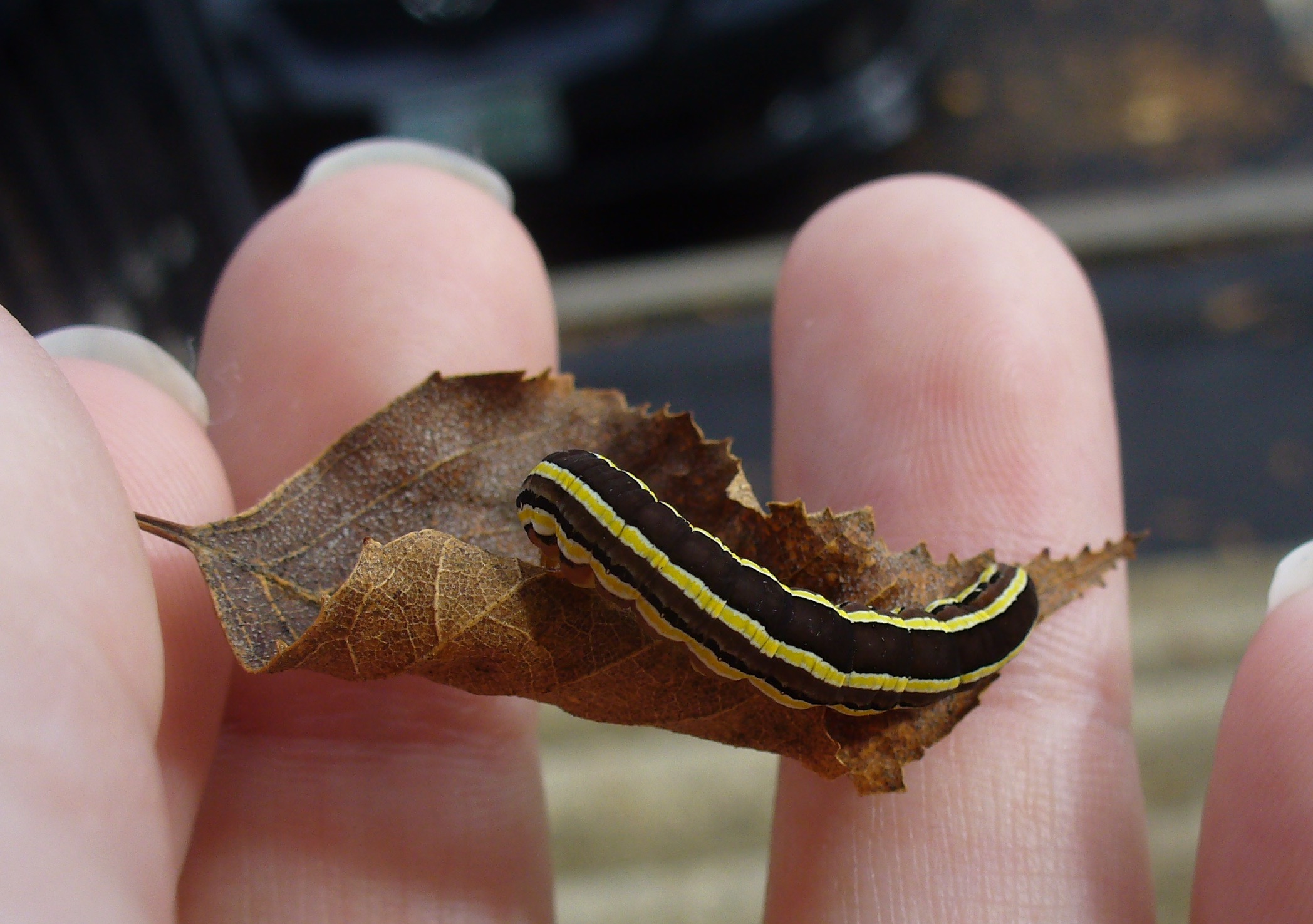
Dr. David L. Wagner, author of the useful Caterpillars of Eastern North America, describes the milkweed feeder on page 415 of his seminal guidebook as a “handsome brown and yellow striped caterpillar.” He recommends looking for them in grass seed heads but adds that he often finds them on the flowers of Goldenrod in the fall.
Perhaps even more handsome is the fluffy Milkweed Tussock Moth caterpillar, Eucaetes Egle. Like so many other insects that use milkweed as their primary food, this creature expresses the cardiac glycosides found in the latex of the milkweed plants with orange and black coloring.
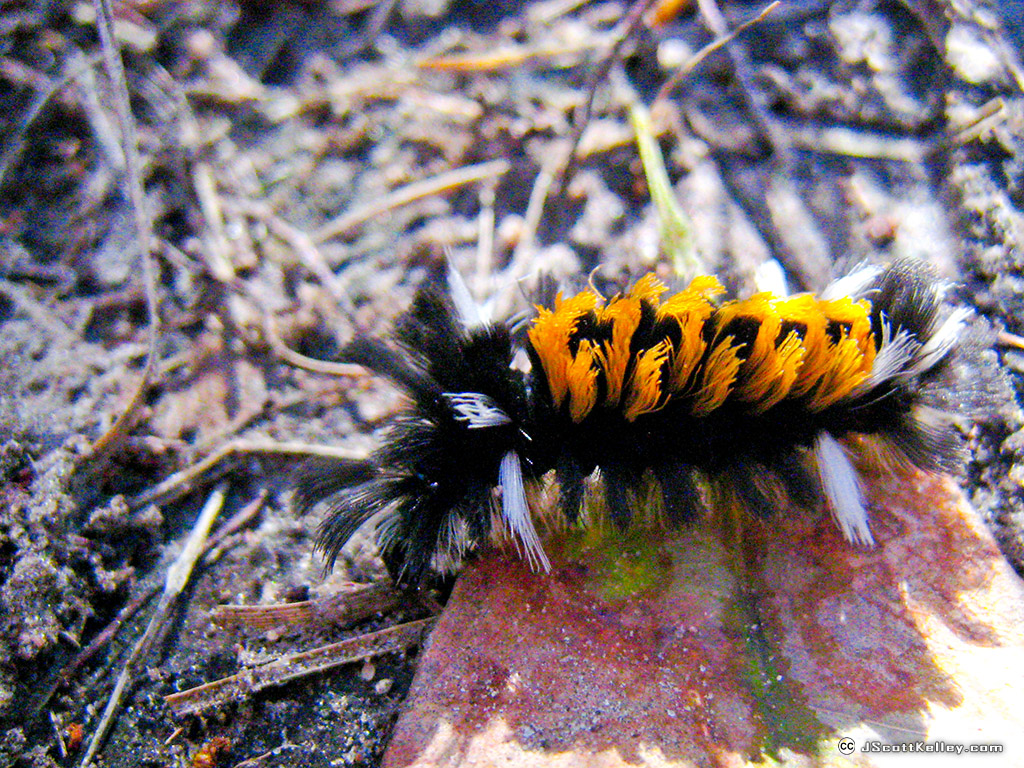
This Tussock moth caterpillar was spotted in Glen Rose, Texas in 2007 walking across a hiking trail in a wooded area. Photo by J. Scott Kelley via Wikipedia.
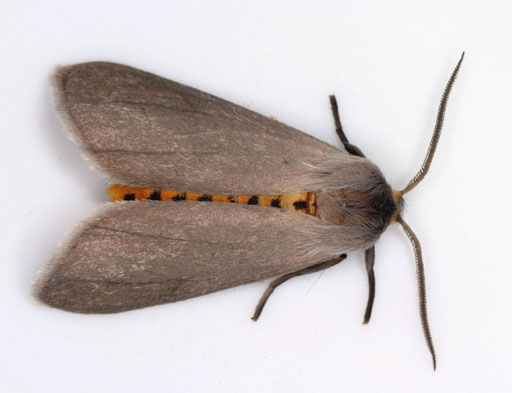
Milkweed Tussock Moth, photo by Patrick Coin via Wikipedia.
The adult form of this moth, below, also displays orange and black on its body, as it peeks through the wings to alert predators–WARNING: I don’t taste good!
Dr. Wagner’s description of the interesting larvae: “densely hairy caterpillar with numerous black, orange (or yellow) and white tufts and lashes.” Yes, “lashes.”
That’s what these hairy protrusions look like–almost colorful bristles on a soft toothbrush extending from the caterpillars body. According to Wagner, the species occurs in Texas and the Southwest, but I have never seen one. Would love to, though.
A third milkweed fan, Cycnia inopinatus, also makes appearances now and then. Kip Kiphart, a trainer for Monarch Larvae Monitoring Project (MLMP) and volunteer at Cibolo Nature Center in Boerne, Texas, reports that the Cycnia pictured below was found in 2003 by Myrna Langford while checking milkweed on Laurel’s Ranch near Comfort, Texas. The Cyncia is considered a first for the area.
Kiphart says Langford brought the caterpillar to a meeting, asking for help in identifying it. “Nobody had any idea what it was. I took it home, took photos, sent them to a number of people and nobody knew what it was,” said Kiphart. Eventually the Cyncia was identified.
It turns into the Unexpected Cyncia moth and feeds exclusively on milkweed. You can see the same orange-and-black expression of other milkweed consumers in the belly of the beast, below. The University of Minnesota, which oversees the MLMP, is seeking citizen science observations and documentation of the moth, which is considered rare and of conservation concern.
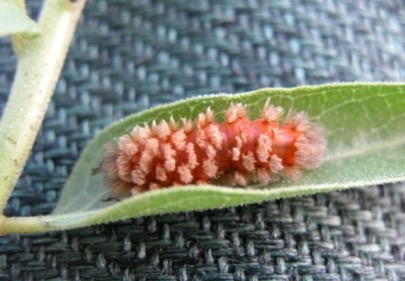
Cyncia inopinatus caterpillar. Another milkweed feeder. Photo by Kip Kiphart
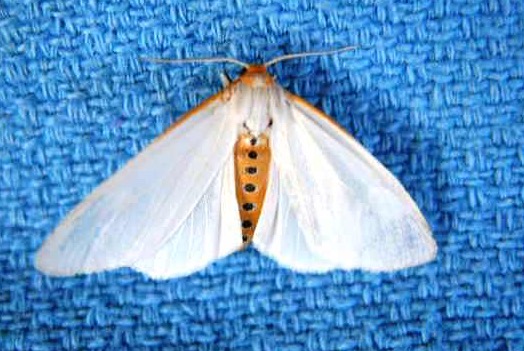
Cyncia adult moth. Photos by Kip Kiphart
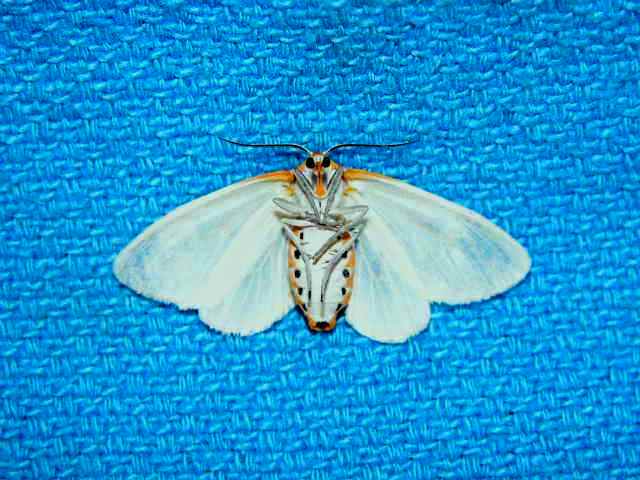
Judging from conversations with folks who work and play a lot with milkweed raising caterpillars and butterflies, these other milkweed eaters are not all that common.
Have you seen any of these other milkweed feeders? Let us know.

Thank you so much for the information regarding other Milkweed caterpillars. Although we are way to north to see them, they certainly are beautiful!
I have photos of a Cyncia moth I found during summer of 2016. This was in Killingworth, Connecticut. I would attach them if I knew how, sorry, they’re on my phone. So beautiful, what a treat!
How far North are you I’m up here in northwestern Wisconsin and I’ve got one of those hairy mothmans eating my milkweed right now my daughter has monarch caterpillars eating her milkweed
I am in Southern Wisconsin and have 5 hairy caterpillars stripping my milkweed right now.
I’m in Connecticut and have two of those fluffy guys on one of my milkweeds at the moment. Been hoping to get some monarchs for years, but these are fun, too.
Same here, in OK, haven’t seen any Monarchs this year, but these guys are munching on milkweed!
Yep. They are in Michigan too. Traverse city.
I have them stripping the leaves from my milkweed. I live in Prince William Count, Virginia.
I have four that are in the chrysalis stage. One should emerge from it this week. Unfortunately, the milkweed in our yard is few. Some of the leaves have curled on a few plants We found the caterpillars when they were small. The one thing that is abundant this year in and around our property is thistles. We are in the Southern Tier of NY state. Our area is under drought conditions. Some rain may come this week, and hope that it will be rain-free when it comes to release the Monarchs when they hatch. We have been doing this for several years with raising Monarchs from the caterpillars. Unfortunately around our yard and nearby the milkweed is not as abundant as it once was.
Live just outside Madison area, we have a ton tussock moth caterpillars. Was confused they were eating milkweed. Checking to see if poisonous since the kids were playing with em. Says they only live in the south like Texas.
I just found some on milkweed in our garden and we live north of Kingston Ontario Canada … and that’s a long way from Texas!
I just found some on a milkweed plant n my yard. I live in central New Hampshire, so they are moving North.
Great visual and educational information. Thanks
I like to PIN these articles to my butterfly board. How can I pin them?
What is this egg from? It is round and a bit fuzzy. I found it on the milkweed I picked for my monarch caterpillars.
I had the Milkweed Tussock Moth caterpillars on my tropical milkweed (Asclepias curassavica) here in east Texas – I stopped in my tracks when I saw them as they were more colorful than the flowers!
Go ahead, rub it in! Jealous. –MM. 😏
I have these in my milkweed in Indiana! Didn’t know anything else ate milkweeds!
We have a family of at least a couple of dozen Tossuck Moth caterpillars on a native milkweed plant in our yard on Long Island, N. Y.
Hi Susan,
I was searching the milkweed in my garden for Monarch larva and found over 30 Tussuck Moth caterpillars on the underneath of 1 or 2 leaves. So interesting as I had never seen this before. I hv them in my butterfly enclosure now and plan to release when mature. Will photograph stages.
I am in Cincinnati, OH and I see the milkweed tussock moth caterpillar on an annual basis. This has actually been a banner year for them as they are stripping my various kinds of milkweed bare. Their eggs are always laid in clusters so it is not uncommon to so 50-100 of these at once. I refer to them as Fuller Brush or pipe cleaner cats. They are cute! But I’d rather have monarch cats. Only 4 so far this year. Last year- over 300. Hoping August gets better.
Great Article! It is good for growers of milkweed to know who else to expect!
We see Tussock moth caterpillars on milkweed all the time here in Ohio. I’ve not seen the other two on it though.
Hi, I am in Wisconsin nd found a cluster of tiny moths. Very light yellow with a black dot on one end. They gave me the creeps. my neighbor and I split the group and are watching them grow. We have a slim yr. for Monarchs. the tiny worms now have black and yellow hairs about 1/4″ long. They eat milkweed leaves. When my neighbor brushed their backs with her finger, she said later her finger was a tad numb We figured that might be their defense against ants and the like.
Thanks for this bit of information. Though the caterpillars are certainly eye-catching, the moths, too, are attractive in their way.
Hi there,
You did not mention the Queen caterpillars…..I have had a couple of them in my yard which is unusual. They left several eggs on milkweeds, and I have enjoyed raising them. They seem to tend to go into the chrysalis very early and don’t wait to get really big before they do it!
Good point! I’ve written alot about Queens, and should have said that in the article. Thanks for pointing it out. Here’s a link for those interested on how to tell the difference between Monarchs and Queens. https://texasbutterflyranch.com/2012/12/07/queen-monarch-caterpillars-and-butterflies-how-to-tell-the-difference/
Great article! A good reminder to us gardeners that there are many moths and butterflies that our plants can play host to – not just monarchs.
That tussock moth caterpillar is a cutie!
Approximately how big are the Cyncia moths? I was digging weeds – leaving the milkweed – and there was a white moth flitting around. I noticed markings but didn’t pay that much attention to what they were.
We see tussock moths yearly on the milkweed. They can strip a milkweed leaf. I also see hummingbird moths, a variety of wasps and bees, assassin bugs, praying mantis and other moths and butterflies.
My milkweed in my yard did not do well this year because of the freaky weather so I did not have many butterflies. I plan to plant more “butterfly” plants next year to make up for millkweed not being there.
My husband and I found a caterpillar eating on milk weed today that we have never seen before. I have been searching on the internet to find what kind it is and I have not found out what it is. It’s mainly all black and fuzzy, but does look to have some orange stripes in between the black fuzzy. It’s eating the milk weed leaves. Anyone know what this might be? We live in North Central Wisconsin.
Probably the Milkweed tussock moth. They’re adorable! –MM
The article didn’t mention the Queen Butterfly (often misidentified as a Monarch), that also host on Milkweed plants.
I found a tussock moth caterpillar on my milkweed this morning when I went to check on my monarch caterpillar. I live near Glen Rose TX. I do not know how to attach picture here. I appreciate your website in helping me identify. Monarch caterpillar is not there, it was too little to go to chrysalis. Queen butterflies will also use milkweed as hosts. Their caterpillar is similar to monarch, but with extra black “horns”. I need to plant more milkweed, my plants have been bare of leaves and blooms for all the caterpillar activity!
question: I went out to my goat hut this evening, and found a female Monarch on the side of the hut. It’s chrysalis was just above it, and I am going to “assume” that it just emerged today. Because it’s to be in the 40’s tonight and down in the 30’s tomorrow night, I brought it in for the night and put in a butterfly house with nectar in gatorade lids with cotton balls. Will it be ok to let it out tomorrow and hope it gets somewhere warmer by tomorrow evening? Help !!!!
I live in Kentucky and I see the ttussock moth caterpillar all of the time they are everywhere at my house.
I have another caterpillar that was eating on my swamp milkweed in Benton County IA and have been trying to ID it. It was a plain blonde fuzzy caterpillar – definatly not a tussock moth – and it was just one individual. I would like to attach an image if you reply to my email.
I live in Wisconsin and just found more than a dozen Tussock Moth on my milkweed. Several if them all feeding on the same leaf. I’ve never seen them before! Beautiful, but definitely a surprise.
A fellow master gardener and Entomology specialist had the orange and black Tussock moth caterpillars on her milkweed recently. She said they were so numerous the milkweed looked black all over! She saved me a few of the cats to raise, and some have already made a cocoon, some are still eating. They are pretty, and although I have only handled them a brief once or twice, no stinging or numbness occurred. It will be fun to see the moths.
Our Ento. group has several members who are enjoying raising as many different kinds of butterflies and moths. I recently had the pleasure of raising a number of Polyphemus moth cats and some IO moth cats. The IO moth cats have lots of stinging points on them, and I only got stung in a couple of spots on a couple of knuckles while I was caring for them. I put ice on it, and it did not last long.
Isn’t it fun to share our experiences and encourage others to learn more about nature?
Some of us are planning a trip to the Rio Grande Valley of Texas in late October to visit all the butterfly nature centers down there, including the National Butterfly Center in Mission, TX, supported by the North American Butterfly Association. Many many butterflies down there including some that come across the Rio Grande River into the South Texas region, so we always come away from our trip with more to add to our life list of butterflies……lots of birds too.
Sorry this is so long MM……….
Unfortunately the Ntl. Butt. Center is looking for backers who can donate to their fight over the planned addition of more miles blocking access to our side for the native animals that have lived down there for so very long. It is scheduled to run three miles through the Santa Ana National Wildlife Refuge in Pharr, which will possibly cause the Refuge to close due to the amount of land it takes and all the equipment and supplies to build the fence. The Refuge opened in 1943, and as I was born and raised in that part of Texas, it makes me want to cry over the lack of care our leaders have over the natural environment of our country!
Yes, very aware of the situation on the border. Just wrote about it here. Take a look: https://texasbutterflyranch.com/2017/07/25/border-wall-at-national-butterfly-center-violates-property-rights-and-worse/
Thanks for reading and writing. –MM
Thanks for letting me vent about the fence situation down in the Valley MM. I’m pretty hot about it!
What can I do to help, while living in Conn.?
Who do I write to?
Write to the President, your senators and congress members, and express yourself to your friends and neighbors to help more people get involved. Pray about it in your daily life. Thank the Lord for supporting our efforts regarding this matter. I do not think fences make for good neighbors!
Thanks for your comments.
Fences make for great neighbors.
I have found a little caterpillar on my milkweed I have not been able to identify. Have a really good close up picture of it would like to share but can’t post here. It’s about 3/8″ long, green with a stripe down it’s back which is black along the edges and kind of a peach to white interior. Any ideas?
Hi, can anyone identify this little caterpillar? It’s on my milkweed. I moved it next door to a coneflower, but he came right back to the milkweed. I wanted to see how badly he wanted the milkweed. That’s why I moved it a few inches over to the other plant.
I’m in New Jersey
Thank you
I forgot to add photo
Can anyone tell me how to add photo
Thank you
I was hoping to see some monarch caterpillars this year and was very excited to see that my milkweed plant had been stripped…but what I found under a bottom leaf was not what I expected! A large bottom leaf was covered in Tussock moth caterpillars! Thank you for your website to help identify them. I’m really hoping they leave some of the milkweed so I can see at least one monarch caterpillar this year!
Lisa in Columbia, Missouri
I found an unexpected cycnia on swamp milkweed this year, and I’ve also found 3 striped garden caterpillars. I also found something else which I haven’t identified yet. I am in Cincinnati OH and raised 35 monarchs this year, so I am surprised I have yet to see a milkweed tussock moth caterpillar. Maybe next year!
I found a larva on my milkweed – definitely not a monarch, I raise them. This one was very small, maybe a third of an inch total, nondescript color, shaped with a little bit of a flare around the head, and when I tried to move it, it reared up at me as if to threaten me and writhed a lot more than the monarchs do.
I looked up early instars of the tussock moth but they seem to have their ‘quills’ even when very small.
Any theories? it was on A. curassavica, I am in Connecticut.
I found a large number (13+) of what I think are Tussock moth caterpillars clustered together on one leaf of a milkweed plant in my flowerbed. I took a pic if you would like to see and help me confirm?
I found three Tussock Moth caterpillars munching on my milkweed when I weeded the garden on Thursday (8/01/18). I’m in Minneapolis, MN. Have yet to see any Monarch caterpillars, though I’ve seen a few butterflies flitting about.
I’m in Kansas and I have seen the Cyncia moth but didn’t know anything about them. This year I have seen the caterpillars.
Thanks for the pictures you were the only one I could find to identify them with.
Tussock moth caterpillars feasting on my milkweed. Central NJ. Cute little things but not the monarchs I wanted.
We found a tussock caterpillar in Northern Ohio. We have lots of Monarchs, too.
We just found Milkweed tussock moth caterpillars munching on my neighbor’s milkweed. No Monarchs though.
Thanks for info on cycnia. I’m in KS I think this is what the hundred+ were that were eating my milkweed. My monarch caterpillars kept disappearing, so bringing them in next year. Od share pic, but see no way to do that. PS…have furry white caterpillars eating milkweed also
i have a picture of the little white furries along with the tussock ones…. Western Wi area. I’m thinking they are the “babies” growing into the more colorful tussock? or females? Creepy creatures!!
I live in Kennebunk, Maine and I have the Tussock caterpillars all over the milk weed growing around my house. According to Wagner, the species occurs in Texas and the Southwest. This statement, from my observations, needs to be revised because I live more than 1000 miles northeast of Texas.
We have found three catapillars on the milkweed that are not Monarchs. They have stripes like the Monarch, but the bottom of them are orange. They do curl up into a circle when disturbed. We are wondering what do they grow up into, as we have not found any information on these.
This site is wonderful, I now know it is the Tuscan moth caterpillars, skeletiz my many milkweed around our yard in Worcester County, Massachusetts. Hoped for Monarch butterflys, but I say the greedy Tuscany spoil Monarchs chances, may be reason for decline in numbers. Caught picture at night, masses of them.
Gillian, Warren MA., have pictures if can send?
While looking at the monarch caterpillars i saw a milkweed leaf half Covered with I think Tussuck .caterpillars. I live in northern Vermont and do not recall seeing it before.
Hi folks
I have you all beat, I have them in Canada in eastern province of New Brunswick in an area called Nackawick. I was really surprised to find 5 to 6 Tussock moth eating away on my milkweed. Man they are suppose to be in Southern states.
I think they got lost.
Have let lots of milkweed grow over the years in central Vermont and get a crop of tussock caterpillars every Fall. They seem to take advantage of the Monarch’s completing their cycle & are more numerous then but they are around when the Monarch caterpillars are still feeding. Have a problem every Fall figuring out the best time to start cleaning up the old milkweeds while not interfering with anyone’s dining. If you have any hints I’d appreciate it.
I live in Central Texas and just saw one of the Tussock Moth caterpillar on one of our Texas Milkweeds yesterday. We live between Georgetown and Florence.
I live in north central Kentucky (Meade county), Just west of Louisville. I bought an Asclepias Incarnata plant last spring. It has what I am pretty sure are Cyncia moth larvae on it. Not sure if it is a significant find, but allows for documentation.
I found a black caterpillar It looked like the second picture on the top of the website, what type is it?
I have at least 40 milkweed plants in various places on our 94 acres in the Missouri Ozarks, and this year I have only seen 1 Monarch butterfly. In years past there have been lots of them, although not so much last year. There used to be so many I raised some of the caterpillars in my butterfly box. Sure miss them. This morning I saw so many Tussock Moth caterpillars on one stem of the milkweed that they had stripped at least 4 of the bottom leaves, leaving them looking like lace. There were probably 30 or more of the Tussock Moths caterpillars, and they were still very small. I also have butterfly bush, butterfly weed, tall Garden Phlox, etc for the bees and butterflies. Sure miss the Monarchs.
We are in Garden City, Missouri and I am shocked that I don’t have an aquarium full of monarch caterpillars, eggs and chrysalis’ I haven’t seen one caterpillar yet on my milkweed. We have over 60 plants. This time last year I was releasing by the dozens.
I have tussock moths in little chute wi. They strip the milkweed and r very aggressive.
At first I didn’t know what tussock moth caterpillars were. I decided to leave them alone – bad idea. They stripped all of my swamp milkweed in 2 days. So I had to squish them. A few more found the common milkweed — squish. Tussock moth caterpillars denude trees and bushes as well as milkweed.
My common milkweed all died of the yellows. At this time I only have a few regrown swamp milkweed and a few tiny pop up common milkweeds and the butterflies are continually laying eggs on them. This year is a wash. Next year, I’ll mow down at least half of my common milkweed so it isn’t so densely packed. Leave lots of space for air circulation. I’ll pinch it back so it doesn’t get floppy. I’ll discard any leaves with eggs of tussock moths and milkweed bugs. I’m sorry about the milkweed bugs and tussock moths but there were far too many of them and they ate too much of whatever milkweed wasn’t killed. Far, far too many milkweed bugs and milkweed beetles. If I still had all my swamp and common milkweed I’d have tons of caterpillars now through mid September.
Plant butterfly weed the monarchs love it.
I live in Northern NJ and have been seeing tons of Tussock Moth caterpillars on our local milkweed plants. We have become a monarch butterfly way station and apparently the town council (Livingston, NJ) is involved in saving the monarchs too. So far this summer we’ve seen yellow swallowtails, black swallowtails, monarchs, viceroys, and more. This year we have more than we’ve had in years.
We went out citizen scientist-ing today, looking for milkweed and evidence of monarch butterflies and/or eggs and caterpillars here in Rosemount, MN. It was our first time looking/researching for the monarch – which we love. Even on our first outing, we learned quite a bit. So we came home armed with lots of photos and started searching the internet. What we saw was a huge group of Tussock Moth caterpillars! We saw 9 monarch butterflies flying around during our walk, and lots of milkweed (although not as much as we would have guessed) but a small area that had this huge group/crop of these moths.
Here in NW lower Michigan, we are OVERRUN with tussock moth caterpillars this year! I’ve only seen 2 monarch caterpillars so far & they seem to have disappeared… Sadly, all our milkweeds are being stripped at a record pace….
the tussock caterpillar is a bad one to have in your milkweed, strips the leaves in no time and moves to another plant, they eat in groups, and when disturbed, they curl and drop faster than you can catch them. I have been using a bucket of water with blue dawn dish soap to get rid of them. my milkweed is for the monarchs. today I found a large monarch caterpillar almost ready to go into its chrysalis (sp?) dead, don’t know what killed it, but was sad to see, but on the bright side found 8 other caterpillars in so mn. so some good
I seen 2 Milkweed plant filled on underside of with those tussock caterpillars here in Western Wi. 2nd one i seen i removed it and did my best to crush it on blacktop. I’ve stopped many places on road sides and very few monarch catapillars. If left a day or two, i see they are gone and big holes in leaves next time. Red bugs/ants, other pests noted also. I had went to butterfly class and the speaker had raised over 200 1 yr. So i’m rescuing 27 so far!!
I am in Stillwater MN and have found many milkweed Tussock on my orange butterfly bushes. Not knowing what they were, I decided to cut off the stems and toss them onto our burn pile. My butterfly bushes are covered with monarch caterpillars and I want them to thrive.
We have the Tussock here in PA as well. I let them live. Monarchs are beautiful without a doubt and I love seeing them but why kill something just because it isn’t as pretty.
glad to say this year we found over 60 caterpillars from july 31 to sept 10, and let over 50 butterflies go. we had some caterpillars die in different stages of their lives from young worm to the cristlas stage. compaired to last year with only about 10. I have been collecting and releasing monarchs for over 40 years, there are bumper years and there are lean years, I look at it as a cycle that happens. I am from southern minnesota
We have 3 or 4 milkweed tussock catepillars. They are really stripping the milkweed in our lawn. I am in Montague, New ersey. It doesn’t sound like they are endangered, but since they are native, I will not destroy them. We have been saving and raising mammoths; we are up to 24 this year and we have to harvest milkweed leaves from nearby fields. This is our 3rd summer. The first year we raised 4.
I live in Holland, MI. Last week I experienced a Tussock moth caterpillar, almost land right on my head, just passed my face, I looked down and thought that looks dangerous so I google lens searched this fluffy bugger numerous times because I had never seen one like this before….crazy to me! I have plenty of up close photos to share.
I live on Cape Cod in MA, we raised several Monarchs and also now have some inside. I went to cut down the milkweed plants in the garden and I found a Milkweed Tussock Moth caterpillar eating the leaves 🙂 Have never seen one before, its really cool looking 🙂
We spotted several of the Tussock moth caterpillars on some milkweed today here in Michigan!
Im in ohio near Cleveland the last few days i have been seeing this fluffly caterpillar on milkweed. Glad to have it identfied!! Says its native to texas and southwest…but here it is in ohio!…. We have alot of problems with a flying milkweed (orange and black also) that left unchecked lays eggs and the young destroy the milkweed havent seen many this year till today which i smashed we had a very cold windy week here with wind chills of – 70. Didnt have many Japanese beetles this year either,a blessing think cold helped but lost several butterfly bushes. We had monarch caterpillars last summer.
I’ve had quite a few here in Michigan as well
The milkweed tossock moth caterpillars have striped our milkweeds in the back yard for the rest of the year in Epping,NH 8/25/2019. 7 or 8 of those little guys striped em all in about 2 weeks.
I live in Rockland County, New York & planted milkweed 5 or 6 years ago. This year is the first year we have seen Monarch caterpillars o our plants. Today, I also just saw 2 Milkweed Tussock Moth caterpillars. Never saw anything like it before!
I live in Minnesota, and my Asclepius Tuberosa milkweed plants are full of fluffy Milkweed Tussock Moth caterpillars right now. There were very few Monarch caterpillars on my milkweed this summer, and sadly, far less monarchs than last year flying around. Last year there were so many monarchs that for several weeks that I drove v-e-r-y slowly on the country roads to try to avoid hitting them. It was amazing! I am not sure what happened this year, except for our extremely late spring. I don’t think I can blame the Tussocks, because they have only appeared this week.
In southern georgian bay, ontario we have a bumper crop of monarchs and they are flying everywhere right now. Totally trying to avoid during our drives. We have also had a few of the fluffy milkweed tussocks eating on our milkweed as we speak. I haven’t seen these before. Thanks to this site for identifying them.
Here in the northeastern corner of Illinois I am for the very first time seeing several of the Tussock moth caterpillars on my milkweed plants. Thank you for helping me identify them. Sadly, i do not have as many Monarch caterpillars as last year.
I’m in meeker county, mn. Rural carrier, 2 years ago I noticed that the monarch’s were attracted to the oil the county spread on the dirt roads. Hardly saw any last year. This week my milkweed is being difoilyaited by “T” Caterpillar. Should I stop them? If I don’t there wont be any pods.
We have been raising Monarchs indoors for several years in the Southern Tier of NY state. The monarchs sure are a hungry bunch so we have to keep getting fresh leaves from our milkweed.
The question we have is how to keep snails from gathering on the milkweed? Does anyone have any ideas on this problem?
I keep trying to teach the snails to fly by flicking them of with my finger.
I live in Maine and have 15 Tussock Moth caterpillars on 4 Milkweed stalks just munching away on the leaves.
We live in southwest Missouri, and I have had tussock moth caterpillars on my milkweed for some time now. Since I had practically no Monarchs this year, I am just letting them eat the milkweed. They are sort of pretty.
I have seen those tussock milkweed caterpillars up here in Southern Canada.
I’m in Vermont. Had a huge # of Monarchs 5 yrs ago or so then very little ’til this year. Having a bumper crop, I see 1-3 new adults every day for the last 4+ weeks & more to come. Let lots of milkweed grow & trying to get neighbors to do the same.
We have tussock moth in Nowthen Minnesota. Are they a pest to monarchs?
Ooops! Forgot to say that the tussocks appeared on the milkweed only a few weeks ago & not many so the Monarchs were pretty much done by then. Lucky!
Anyone know what this is on my milkweed? Argh I don’t know how to attach a pic…
I have the Cyncia inopinatus caterpillar on my milk weed this year. Had the Tussocks last year. Have never seen monarch worm ever on my milkweed in 3 or 4 years.
I have found the Cyncia caterpillar on my milkweed this year. We live in Southeast Nebraska, and this is the first time in the 13 years we have lived at our address that I have found these caterpillars. I am currently attempting to raise two of the. The caterpillars will roll up and fall of their leaf/milkweed easily, I assume that is a defensive mechanism. Thank You for your info as I have not found the Cyncia in my Butterflies and Moths book.
Hello. I live in southeastern Pennsylvania (Chambersburg area) and was inspecting my milkweed for Monarch caterpillars. I did not find any of those but I did run across a cute little fellow which Google showed is a Tussock Moth caterpillar. I’ve only ever encountered one other unique caterpillar and that was the Saddleback Caterpillar. Just thought I would share.
I live near Newville, PA and have also seen lots of the Tussock moth caterpillars defoliating my milkweed. The only Monarchs I’ve seen yet are the ones I released a few days ago. The fact that I had five caterpillars to raise and release does mean that the adults had been her though!
I live in Cleveland Ohio. I was just checking my Milkweed for Monarch Lava and found a Load of Tussock Moth Caterpillars….
thanks to your website I now know what they are, Thanks
I’ve found lime green round eggs on my milkweed. Any idea what they could be?
We live in Northern Lower Michigan, and we’ve had many tussock moth caterpillars on our milkweed this year.
We live in the middle of the mitten in Michigan and we have a lot milkweed around us. Recently we have seen quite a few Tussock moth caterpillars on some of the plants. Seeing them eat milkweed leaves, I thought they might be young monarch caterpillars until I got to this website and found out otherwise. We have so many milkweed in the area, I’m sure there’s enough for both the Monarch and Tussock.
I live in Southern NJ, 15 mins from Phila, and just found at least 50 of the Tussock moth caterpillars on my milkweed, but no Monarchs. So far this year the butterflies (all varieties) and bees have been extremely scarce even though I have many different flowers planted just for them. Sure hope the scarcity doesn’t become the norm.
I have caterpillars on my milkweed and they resemble monarchs but rather than having a pair of tentacles at the front and the back they also have a pair of tentacles, for lack of better description, close to the center of their bodies. But otherwise they look like monarchs. Are they?
What about a light green insect that looks like a small worm. I found it on milkweed and it is eating it voraciously! What is it? (I don’t think it is a caterpillar.)
Thanks for a super informative blog post!
@ Richard Kutner
That caterpillar that you are talking about is called a queen caterpillar. They look quite similar to the monarch- as a caterpillar and butterfly.
I live in sussex nj , and have many tussock moth caterpillars on my milkweed. I have some caged along with a few monarch caterpillars. Is the moth butterfly a good species to have around my house and plants?
I have small inch long caterpillars on my asclepias and on my large swamp milkweed bush. Orange/rust colored body and short black fuzz all over it. I doubt it is the Tussock moth caterpillar, has no white hairs on it. I’ve looked at so many photos on the internet and cannot find out what these are. Thanks for any assistance; I don’t know whether to get rid of them, or not.
I have Tussock moth catepillars on my milkweed. I’m 8 miles south of Madison, Wisconsin.
I found 3 of the Tussock on my deck today. Never seen them before but we do have Milkweed. We live in Northeast Pa.
I saw a few Cyncia inopinatus caterpillars on two of our orange milkweeds earlier this summer just outside of Goessel, Kansas.
There is an army of Milkweed Tussock Moth caterpillar on our crop of milkweek which we grow for the Monarchs. Should we allow the Tussock Moth caterpillars to graze at their leisure. As many as there are there will be no milkweed left for the Monarch caterpillars. Thank you.
Hi Bonnie
I’m in Virginia and have a ton of these on our milkweed. I am wondering the same thing as you,
Marsha
I got eight milkweed plants of various varieties this spring. It is now late July and the plants are doing well. A few weeks ago I noticed a couple of Tussock moth caterpillars on them, then they disappeared. Now, I have three Monarch caterpillars and one Tussock Moth caterpillar. I noticed a bunch of aphids on one of the plants a few days ago and I found that painter’s tape worked well to take them off without damaging the plant. I’m in Maryland.
Pretty sure I just saw a tussock caterpillar on my milkweed. Way up in western NY.
I have a picture but can’t attach it.
Found a small colony of Milkweed Tussock Moth caterpillars along Peterson Road in Sleeping Bear Dunes National Lakeshore.
First sighting for me. Northwestern Michigan.
I saw this caterpillar eating zizotes milkweeds and butterfly milkweeds in my garden in West Texas. What’s odd is those milkweeds have different saps. Zizotes is a favorite of monarchs while butterfly milkweed is the only milkweed without milky sap. All this time I thought only monarchs, queens and viceroys ate milkweeds. Thanks for the ID!
On my newly planted milkweed I’m finding some leaves folded and inside is a small 1/2in. White caterpillar. No markings. What is it. And I’ve noticed some leaves have been chewed. Not seeing monarch caterpillars yet
Much to my surprise I have discovered monarch caterpillars feeding on plumeria leaves. Raising several of these caterpillars on plumeria. Also , a few days ago I watched a female monarch laying eggs on my plumerias. Have photographic evidence thereof.
Believe I have Cycnia inopinatus on my Butterfly Weed plants (milk weed plant) in north central Oklahoma. , Second year observed.